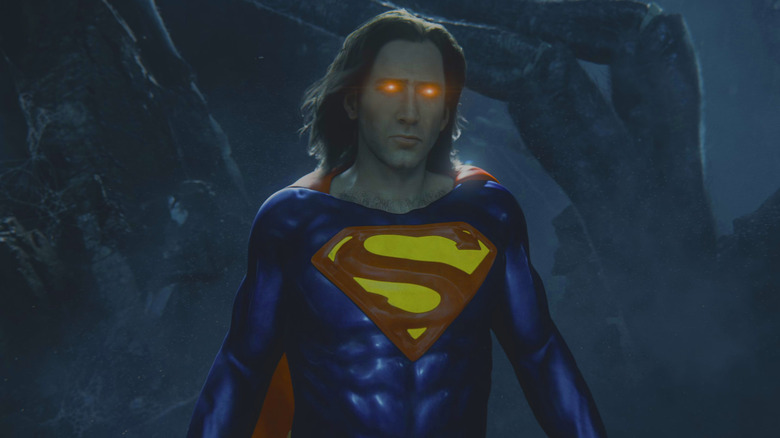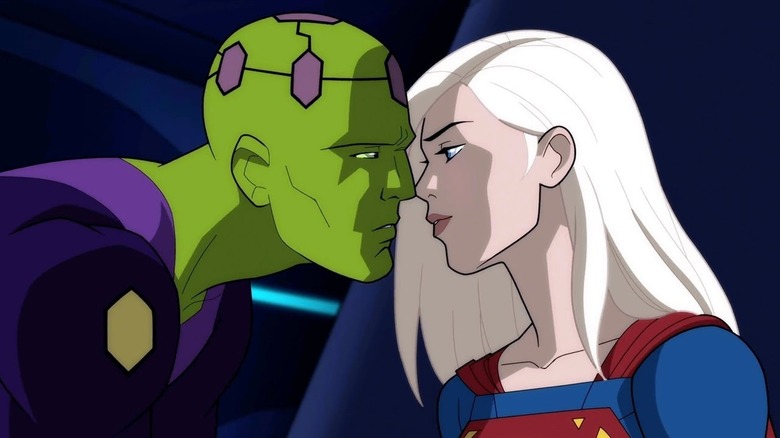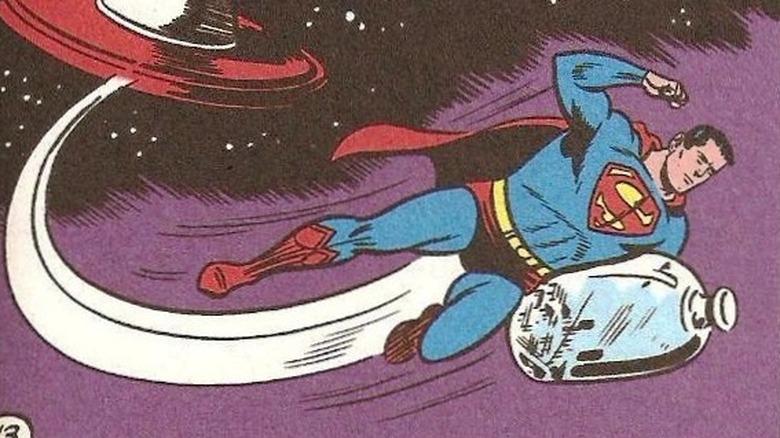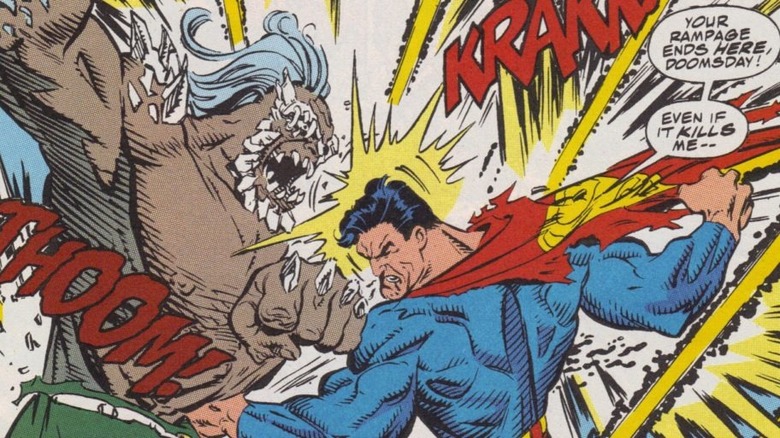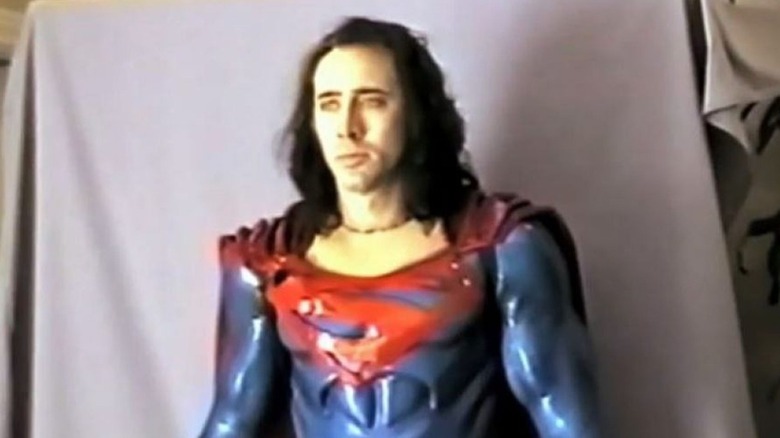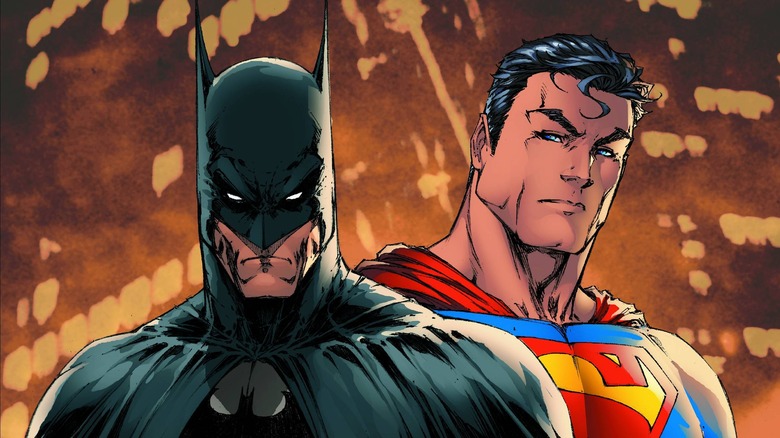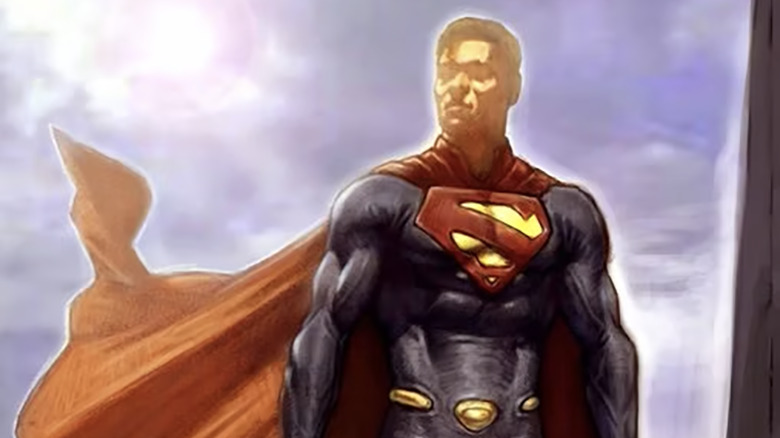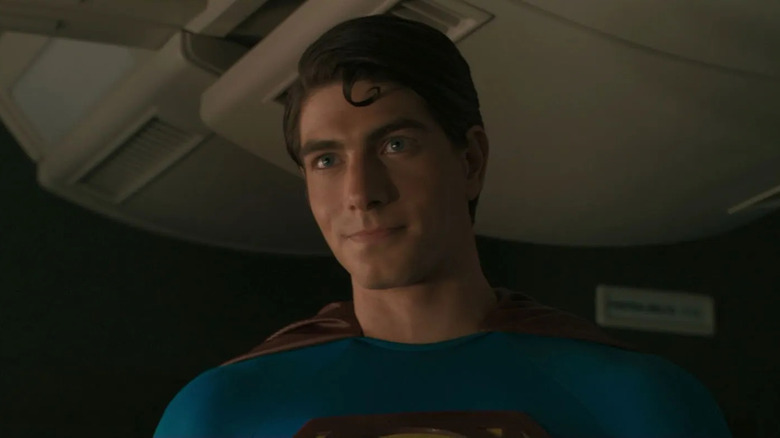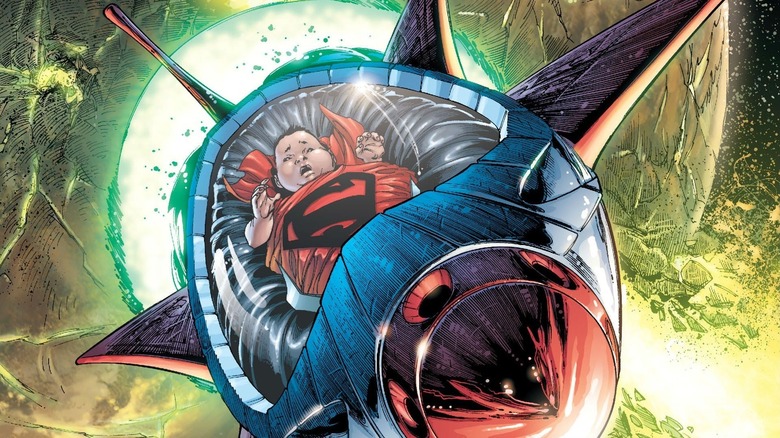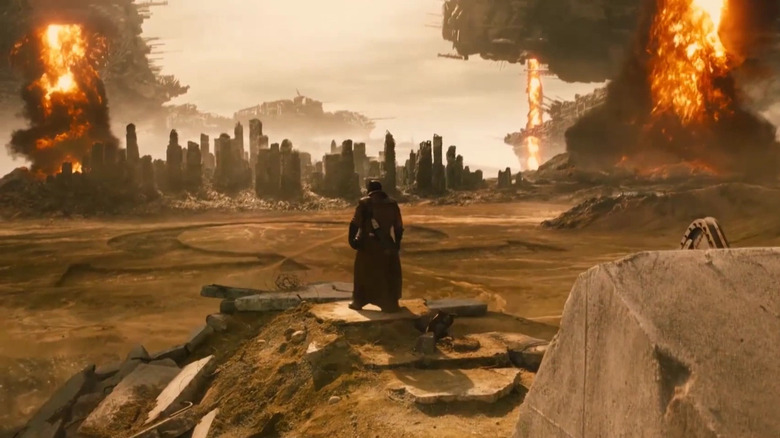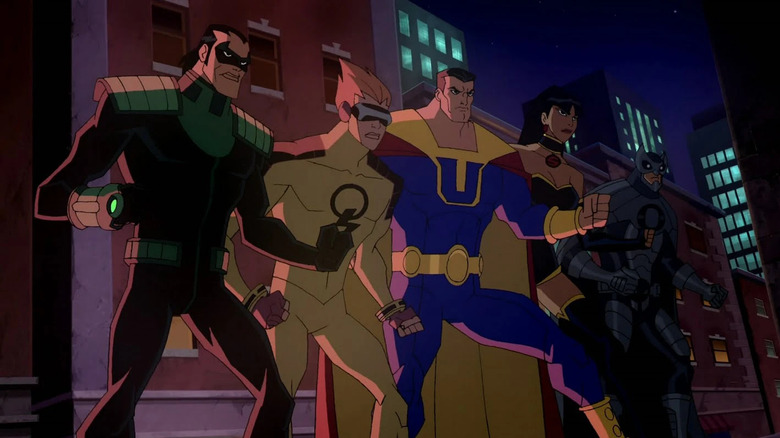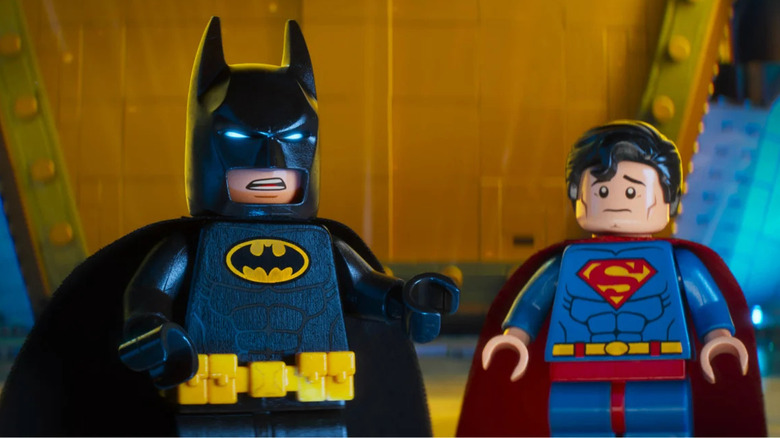Bizarre Canceled Superman Movies We Never Got To See
There is yet another Superman reboot on the horizon, this time courtesy of James Gunn and Peter Safran, and much of it is being kept under wraps. This is, dare I say, a good thing, because the last thing we need is yet another troubled Superman production. Despite the character's enduring cinematic legacy, almost none of his cinematic solo outings can be discussed without their lingering baggage: creative infighting, script leaks, casting rumor mills, and even the occasional director's cut long after release. For a hero that is seemingly impenetrable, the Man of Steel sure has taken a beating in development hell.
Part of the problem is that nobody can quite agree on who Superman is or should be. In the early days, Warner Bros. avoided bogging Superman down in comics lore. Then, when fans became outraged over creative liberties, the studio frantically tried to cater to them. Superman used to strive for a clean, boy scout look. Then, Batman's darkness swept the nation, and suddenly Superman looked silly. Clark Kent needed to become dark and brooding, which we have since driven into the ground with years of the Snyderverse. Will Gunn and Safran course correct in some other way? Well, they have plenty of material to work with, if they do.
Here are just some of Superman's production detours from over the years, both live-action and animated.
Superman III almost had Supergirl, Brainiac, and Mr. Mxyzptlk
The Man of Steel's production woes began early. Following the success of the first "Superman" film, director Richard Donner was fired from the ongoing production of "Superman II" due to tensions between him and producers Ilya and Alexander Salkind. The sequel was still a success, however, prompting the Salkinds to announce a third film. Donner had salvaged much of the original films' disastrous scripts, leaving the Salkinds at square one for the next film's story.
Ilya, in all of his misguided fervor, wrote an initial treatment outlining his vision for "Superman III" in 1980 (via Meat Fighter). The treatment most notably brought Supergirl and Brainiac into the franchise but with a story that considerably diverged from the comics. Salkind framed their introduction as an intergalactic father-daughter relationship that gets complicated when Brainiac's fatherly love gradually becomes romantic (Gross!). Eventually, Superman falls for her too — Lois Lane has conveniently moved away — and Supergirl reciprocates, leading to Brainiac lusting for revenge. Oh, and Mr. Mxyzptlk is thrown in there as a brief diversion for good measure, though Superman easily tosses him to the side.
Warner Bros. would ultimately scrap the treatment, deeming it too bogged in comics lore, however, some concepts were transferred over to the final version, including a divergent, evil version of Superman whom Clark Kent must defeat.
Superman V would have shrunk Superman to Kandor
Following the critical and commercial dud that was the franchise's fourth installment, "Superman IV: The Quest for Peace," it's hard to imagine how anyone saw potential for a hypothetical "Superman V." Despite this, the film was announced in 1988, beginning what would become over 15 years of development hell attempting to produce a follow-up. At first, Cannon/Golan (then-owners of the franchise ) were set on producing the fifth film, however, the partnership's dissolution following Cannon's descent into bankruptcy made their efforts all but moot.
Eventually, the film rights reverted back to Ilya Salkind, who was ready to return to the franchise he helped build. Once again hashing out the story, this time with the help of "Superman" comics writer Cary Bates and screenwriter Mark Jones, "Superman V" would see Supes die and miraculously reawaken in the shrunken Kryptonian city of Kandor, now housed in a bottle and monitored by Brainiac –- yet another attempt to introduce the seminal Superman villain into the live-action films. Turns out, the mad genius had a collection of miniature cities, including, eventually, Metropolis.
Once again, Warner Bros. was not enthused with Salkind's pitch, in fact, now even less so. Following the smashing success of Tim Burton's "Batman," the studio was keen to re-acquire Superman's film rights for themselves. After locking Salkind out of negotiations, they forced their own acquisition in 1993, permanently pulling Salkind's grubby hands off of the film franchise for good.
Superman Reborn tried (and failed) to adapt The Death of Superman
The 1992 "Death of Superman" comic book storyline skyrocketed Superman's popularity amidst his Hollywood woes, so it's no surprise Warner Bros. saw it as a chance to reboot the film series. The studio looped in Jon Peters, the producer of 1989's "Batman," who then looped in screenwriter Johnathan Lemkin for what was dubbed "Superman Reborn." Lemkin's initial script (via Superman Homepage) played fast and loose with the original comic, killing Superman at the hands of Doomsday but not without having him spiritually impregnate Lois Lane first. That bizarre concept was only further hindered by the script's cynicism over the character, which led to Lemkin's ousting.
Peters' replacement was Gregory Poirier, who had previously penned pornos and b-movies. His take on Superman (also via Superman Homepage) was packed to the brim with villains, including another attempt to introduce Brainiac along with Doomsday, Parasite, and even Silver Banshee. It also portrayed Superman with several new elements: a jet black suit (at the request of Peters), martial arts abilities, and visits to his psychiatrist, the last of which was particularly confounding to Warner Bros. executives. Even a cameo from Batman at Superman's funeral wasn't enough to convince the studio that Poirier had the goods, leaving Peters without a writer yet again. Peter's third choice of writer, Kevin Smith, would lead directly into Superman's most infamously abandoned project...
Superman Lives nearly gave us Nicolas Cage as Superman
Much has already been said about "Superman Lives," one of Kevin Smith's many long-belabored projects that saw him getting a shot at the Last Son of Krypton. Following the success of "Clerks," Smith was brought onto "Superman Reborn" to inject it with some comic book credibility. After deeming Gregory Poirier's script laughable, he rewrote the film as "Superman Lives," a version that saw Brainiac teaming up with Lex Luthor to block the sun and let Doomsday loose. Smith's take was far more rooted in the original comic while still feeling fun and upbeat, however Peters' ridiculous demands — including that Superman could not fly and that he had to fight a giant spider — forced Smith to make some concessions.
Smith's script caught the attention of two big names: Tim Burton, who would be back in a DC director's chair, and Nicolas Cage, who would star as Superman. Smith's version was set for a 1998 release, however, Burton unceremoniously discarded the script as soon as he signed on. Smith was replaced by Wesley Strick, who further edited the story to accentuate Superman's struggle feeling accepted by the world due to his alien origins, which would have made Cage's unorthodox casting ideal. Meanwhile, Burton was adding his uniquely twisted sensibilities to the film's aesthetic, with sets being built while the script got a pass from writer Dan Gilroy. The film's pre-production ballooned its budget to over $100 million, leading Warner to eventually pull the plug. However, Smith would receive vindication years later in "The Flash," where Cage's Superman is given a surprise cameo.
The original Batman v. Superman had The Joker kill Batman's wife
Zack Snyder tackled the cinematic brawl between Batman and Superman in 2016 (we'll get to the DCEU momentarily), but Warner Bros. had considered trying it as early as 1998. With both film franchises in a slump, a team-up movie seemed like a natural way to give both parties a jump start. Originally written by Andrew Kevin Walker and then revised by Akiva Goldsman, the script (via Superman Homepage), subtitled "Asylum," jumped ahead five years into Batman's retirement, following the death of Robin. Bruce Wayne, now married, is living peacefully until The Joker kills his wife with a poison dart. Bruce puts on the cowl again to seek vengeance, leading Superman to intervene. We do get a solid fight between them, however, they decide to work together after learning the true mastermind behind Bruce's misery: Lex Luthor.
"Asylum" was a darker take on the DC universe but one that was welcomed by executives. The film's release was slated for 2004, but things quickly became complicated by a new player in town. J.J. Abrams, known then for his hit show "Alias," had submitted his own draft of a Superman trilogy with the first film codenamed "Superman: FlyBy." Abrams argued that a team-up movie was no use unless you did the work to establish the heroes individually. Warner pitted both scripts against each other, and after a unanimous vote, "FlyBy" won. "Asylum" was put on hold, and Superman's belabored development continued. Meanwhile, Batman would be handed off to some dude named Christopher Nolan, and the rest is history.
In Superman: FlyBy, J.J. Abrams made Lex Luthor a Kryptonian
J. J. Abrams was off to the races with his version of the Man of Steel, dubbed "Superman: FlyBy," which was partnered with "Charlie's Angels" director McG. Abrams conceived of a trilogy of films, beginning with an origin story that saw several unique changes to the source material (via Cashiers du Cinemart). For one, Krypton would not be destroyed, but it would endure a civil war. Kal-El would be sent away in hopes of one day saving the planet, leading him to Ma and Pa Kent down on Earth. Clark grows up suppressing his powers, eventually meeting Lex Luthor, reimagined as an Earth-bound Kryptonian posing as a CIA agent in search of alien activity. Also, Superman's suit comes in a can. Seriously.
The film's reimagining of the Superman mythos made the rounds online and received intense backlash, pressuring McG off the project. Brett Ratner would quickly replace McG, however, Ratner and Jon Peters, still the character's reigning producer, disagreed over how to cast the character: Ratner wanted an unknown, Peters (and, by extension, Warner Bros.) wanted a recognizable star. The infighting proved so contentious that Ratner would eventually depart the project. Abrams threw his hat into the ring, eager to get his chance to direct a feature film, but Warner refused to take such a risk. Despite concept art already being developed, the project eventually stalled out, allowing one Bryan Singer to pitch his own unique vision for the character: go back to the Donner films with "Superman Returns."
The sequel to Superman Returns would have given Superman a body count
"Superman Returns," the first cinematic solo outing for the Man of Steel in nearly 20 years, was already tracking to be a success before its release in 2006. Thus, Bryan Singer began pitching a sequel dubbed "Superman: Man of Steel," which flirted with including villains like Darkseid, Brainiac (this guy can't catch a break), or even Bizarro (via Rotten Tomatoes). However, its box office debut and lukewarm fan reception didn't quite match WB's hopes, leading them to play hooky with a sequel for years until Brandon Routh's contract eventually expired.
Amidst its on-again-off-again development, Singer assured fans that the "Returns" sequel would be a tonal departure from the first film, joking to Empire that Superman would have "a body count" and bring "unrelenting terror." However, no official story had been written, according to "Returns" co-writer Michael Dougherty (via Moviehole), who shared Singer's sentiments, saying he would have added more action to the sequel and incorporated Brainiac as the big bad. The film also would have introduced other Kryptonians to Earth and explored how they would adapt to their new powers, similar to Clark's journey in his early years. Sadly, Dougherty never got the call, and Superman would remain in limbo until Zack Snyder's "Man of Steel" in 2013.
Matthew Vaughn's proposed Superman Trilogy delayed Krypton's destruction
"Superman Returns" was technically a sequel to the Richard Donner films, which gave Warner Bros. room to once again attempt genuinely rebooting the character and his origins. One pitch came courtesy of Matthew Vaughn, who hadn't even directed "Kick-Ass" at this time, and comic writer Mark Millar in 2008. Their proposed trilogy of films would have followed in the spirit of Donner's film, epic in scale but uplifting in tone (via ComingSoon.net), but they were set on telling their own story.
Their main twist was that the story would have heavily focused on the politics of Krypton, to the point that the first film was almost entirely set there (via Polygon). Superman's father, Jor-El, would still send Superman away, believing the planet was doomed, but he would have misjudged the timing. Krypton's destruction would have occurred later in Clark's life, causing what Vaughn described as a Kryptonian "mass exodus" (via Happy Sad Confused) and forcing Clark to reconcile his alien origins with his life on Earth.
Warner Bros. never took the bait, though Vaughn would later be courted to potentially direct "Man of Steel 2", where he would have incorporated some of his ideas. As we know, the belabored sequel to Zack Snyder's reboot is a whole other story.
In Zack Snyder's Justice League sequels, Superman and Lois Lane birthed the next Batman
After all the hullabaloo surrounding the four-hour "Snyder Cut" of "Justice League," Zack Snyder still had two more Justice League movies in him, and the plot would've taken some seriously drastic turns. As it turns out, Snyder's vision for the Snyderverse was actually five parts. The first two were "Man of Steel" and "Batman v Superman: Dawn of Justice," followed by "Justice League," which foreshadows apocalyptic visions of the impending arrival of Darkseid.
Well, the fourth part of the saga would have introduced the villain by having him kill Lois Lane, leaving Superman emotionally destroyed and susceptible to the "Anti-Life Equation," a special formula that allows Darkseid to assume control of any sentient being. Batman, who swore to Superman he would protect Lois Lane, fails to do so; in fact, he actually falls in love with her and, when she gets pregnant, assumes the child is his. Darkseid winds up taking over the world, however Cyborg reprograms a Mother Box to send Flash back in time to warn Batman (this is portrayed in "Batman v Superman"), where he then sacrifices himself to save Lois and, subsequently, the rest of the world.
The fifth film? One big ol' war between good and evil. To top it all off, Lois' child is revealed to be Superman's son, who would grow up to become the new Batman. If you can believe it, none of this came to fruition, as Snyder would depart the series following the debatable success of his "Snyder Cut."
The animated Justice League series almost got a movie with The Crime Syndicate
Let's take a step back from Supes' live-action outings and enter the world of animation. After all, the character's first appearance off-the-page was in Fleischer Studios' cartoons during the 1940s, and since then, he has had several successful animated films and television shows. One of them was the Cartoon Network series "Justice League," which the network sought to renew for a third and fourth season in 2003 but with a rebranding to keep things fresh. Series creator Bruce Timm and his creative team decided to expand the roster of heroes significantly, eventually conceiving the sister series "Justice League Unlimited."
Around the same time, according to Timm, DC Television commissioned a film installment for the series as well (via Toon Zone). Timm and his team used this opportunity to bridge both shows together with a story titled "Worlds Collide," which saw the League encounter the Crime Syndicate, a host of villainous alter egos from another dimension. The series would have eventually set up the larger League and even introduced Wonder Woman's Invisible Jet. The film had its script, cast, and character designs ready to go, but DCTV ultimately pulled the plug for reasons unknown. Timm has no regrets about it, though, as he would later resuscitate the film in 2010 for "Justice League: Crisis on Two Earths," which featured the same plot but rewritten to excise any of the show's continuity (sorry John Stewart).
LEGO Batman 2 would have included Superman as a main character
Out of all the canceled Superman projects, this one maybe hurts the most... and it's not even technically a Superman movie!
The DC superheroes have had their fair share of time in the LEGO limelight, most notably in "The LEGO Batman Movie." The film's box office success kickstarted a sequel with Chris McKay returning to direct, but the lackluster performance of "The LEGO Movie 2: The Second Part" kept Warner Bros. from pursuing further movies. Adding insult to injury, they let their contract to the franchise's film rights expire, leaving Universal the chance to take over. Because Batman is owned by Warner Bros., Universal won't be making a LEGO Batman movie anytime soon.
It's a real shame, given that a "LEGO Batman" sequel had been fully written and it sounded damn good. This time, Dan Harmon and Michael Waldron penned the script, which was more of a "Superfriends" movie as opposed to another solo outing. The film took a "Godfather Part II" approach to its story, jumping back and forth between a present day Justice League mission against Lex Luthor and the origins behind how the League came together. Heavily featured in that story was the relationship between Batman and Superman, specifically how they both learn what it means to sustain a healthy, years-long friendship. McKay also teased a gigantic crossover with another franchise (via Uproxx), though which one it was we will never know.
